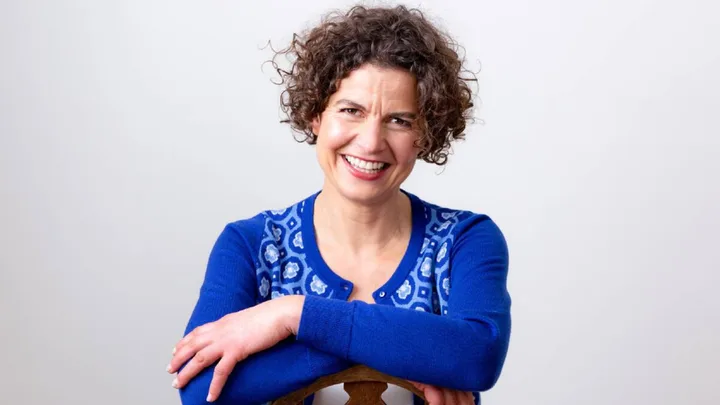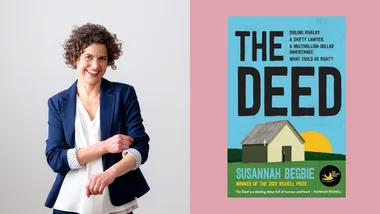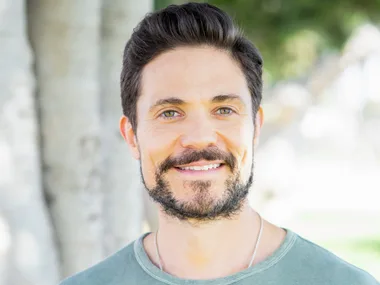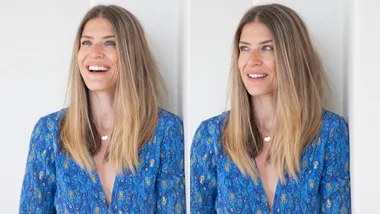AWW: In The Deed, a father sets a task for his four children to complete together in order to inherit the family farm. It’s such an original concept. When did you first come up with the idea?
Susannah: I don’t know! The coffin building part of it is not uncommon. There’s a group down in Tasmania that is a support group for people who want to build a coffin for their loved one, and I understand it’s a very cathartic and meaningful experience.
I can see that that would be the case. But this idea of a wealthy old farmer who’s dying and cranky with everything – who makes his kids build his coffin to earn their inheritance, I have no idea where that came from. But when it occurred to me, it made me laugh. And it made me think ‘who would do that to their family? How would it even cross his mind?’ And that’s where writing begins for me, with a question.
It feels like you were constantly asking yourself in the process because every character we meet, you want to interrogate.
I think that’s absolutely right. As you know, Tom Edwards has four children – Jenny, David, Christine and Sophie – and they come back to the farm after their father dies to hear his new will: they have to build his coffin in four days to get their inheritance, otherwise they lose the lot. Twenty million dollars’ worth. And they are faced with the conundrum to do with that instruction. This set-up is where we begin to understand what’s happening for the characters. They’re not all nice and they’re definitely not nice all of the time. The siblings are reckoning with their past; with the choices they’ve made in their own lives; with their relationship with their father, Tom Edwards and finally their relationships with each other.
Everything that one of them does impacts the other siblings, and I would be asking myself all the time what effect that would have, if Sophie did x, or Dave said y. One character’s action will bring up things for the others that maybe are unexpected or remind them of an event that they haven’t thought of in years, or even just determine the practicality of what they’re going to do on that day. As well as facing all the things from their past, they have to work out how to manage their current situation.
The four Edwards children are such well-drawn characters. Quiet, nervous Jenny. Unstoppable, ambitious Chris. Aggrieved business owner Dave. Irresponsible Sophie, who’s searching for her purpose. Over the ten years you were developing the story how much did the composition of the Edwards siblings change? Were there always four or them? Were there always three daughters and a son?
The way writing the novel began was, I’d written a few short stories, and I had this idea of the farmer putting the coffin task on his kids, as a bitter joke, more or less. I took it to a plotting workshop, and everyone said you can’t do that as a short story. It’s got to be a novel.
Because I had no idea what I was doing, for the first couple of years the writing was experimental. I was just trying things out. I would start with doing random stream-of-consciousness writing and I’d chose a word out of that or a phrase or a place and I’d write around that thing.
I think I had four siblings from the start. I don’t remember if I had any other thoughts about them at that point. The characters they became grew out of the writing process.
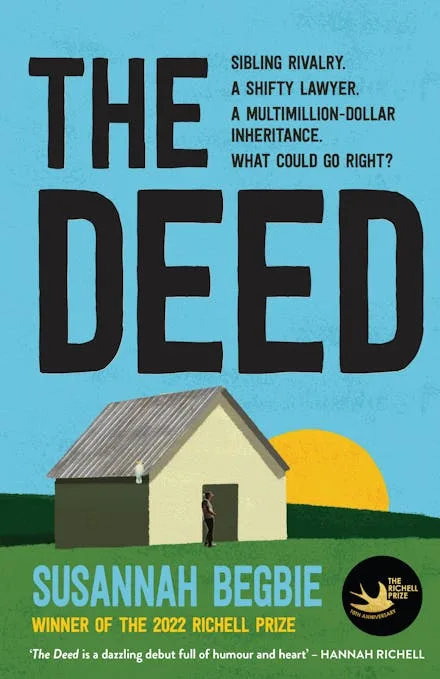
It’s so interesting that you went to a plotting workshop because I was curious how you kept the story straight in your mind. We have dual timelines and a lot of characters who each have their own arc. Can you share a little of your process for keeping everything straight in your mind? Are you someone who has spreadsheets, or a detailed outline? Are you a plotter or a pantser?
I’m both. I started off with this very unclear and exploratory frame of mind. But about halfway through writing The Deed I thought ‘this could be trouble, this situation I’m in here.’ And then I started to pay attention to details, so that I could be sure that a) what happens could happen. To make sure it was physically possible. And b) it was in a timeframe that was real.
I made family trees. Five generations of the Edwards family. I made maps and property boundaries and floorplans of the house and then I did colour-coded chapters. As you know, the chapters are told from the points of view of each of the six characters and so I did colour-coded chapters and made a list of them to give me an idea of how well-spread out the different voices were. By the end it was highly structured.
Tell me about the process of creating Ellersley. It feels so alive on the page. Did it involve a lot of walking around the family farm to soak up the smells, sights and sounds of farm life?
Ellersley is set in the Riverina. I’m from the Eden-Monaro area. That country tends to be dry and a bit poor in the topsoil. The Riverina is much more green and lush. I went down to Wagga. I drove down there and spent a weekend looking around. I wanted to be sure that the property I was imagining was possible in real life.
Ellersley’s a 10,000-acre property. It’s got a few kilometers of river flats which is prime land, the river flats – they’ve got all that lovely silt that come down from the river. I wanted a reasonable amount of the land to be grazing country. Hills were fine but it still needed to grow some lovely grass. The rest of it was to be scrub up the back of the property. Different parts of the plotting and narrative occur in different parts of the landscape.
I found this area northeast of Wagga that was beautiful country, and perfect for the job.
There are things in my book that are derived from my childhood. The Deed became something of a love song to the landscape of my childhood. It was such a pleasure to spend time in remembering those places. It was an unexpected joy of the process of writing the novel.
What about farming life did you want to convey with The Deed?
I would say the inheritance and succession planning is one part of the novel and the other part is the reality of living on the farm and deriving income from that farm, so that your family’s prosperity depends on the landscape that you’re in and the work that you do on that land.
We live in an incredibly beautiful country. It’s just an amazing country. At the moment, in my job as a GP, I’m doing locum work in rural Australia. I’ll go to a rural town, and I’ll spend a month or two there, and during that time get to explore a new area of the Australian rural landscape.
The farming life that I have written about in The Deed is partly from my own experience, but also learned from the people I have met in my work. These people are hardworking people who have a passion for the land that their families have lived on for generations.
The understanding of family is as much about the farm as it is about the family, and the question of managing the property is also about your family. Inheritance and succession planning are a consequence of this situation. The land is an integral part of how the family works, and the family has to work for the land to be managed.
So in a situation like the one in The Deed, Tom Edwards is absolutely in that frame of mind where the only option is for his kids to take on the responsibility of the farm: if they don’t, they’ve failed him. It’s really hard for him and it’s really hard for the kids too.
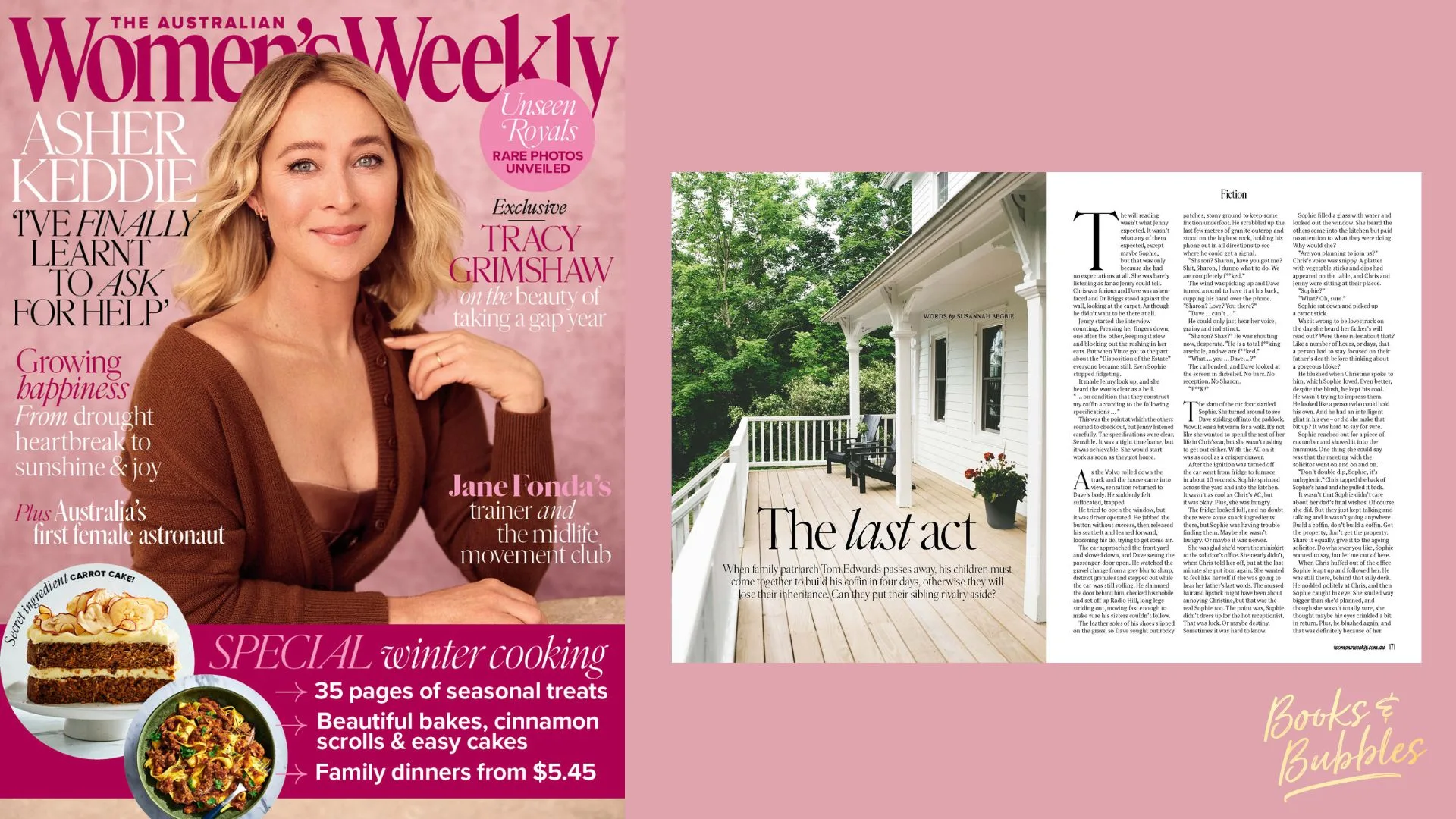
You work as a GP. When do you get your writing done? Do you have a set routine, or do you squeeze it in wherever possible?
I work as a GP part-time, and I work as a writer part-time. So there are no heroics. I am fortunate to have a two-book contract with Hachette, and when I got that contract, I realised that I needed to set aside writing time. That’s when I started doing only rural locums. I’ll go and do a locum for a month and then I’ll come home and write for a month.
You enrolled in a creative writing course after blogging about your experience working as a locum in Ireland. Can you share a little about how you came to write about that job?
I was working on the west coast of Ireland and the places that I went to were impossible beautiful. And most days something would happen that was entertaining so I started writing accounts of these things to the people back home, and I just loved it.
I loved the process of writing those events down. I hadn’t expected that.
And from there you enrolled in a Creative Writing Course?
I came back from Ireland and a good friend of mine who is also a GP and a writer said I should do this course at Canberra Uni, that I’d really enjoy it. At that stage I was only writing for my own pleasure. I had no expectation that it would go anywhere. I was just doing it because it’s good to do creative things.
It’s good for your mind and your heart. It was during that time that I took the idea for The Deed to a plotting workshop.
Is there one particular piece of writing advice that really helped you complete your novel?
The one piece of advice that is going to stick with me my entire writing life is you have to write. Just write. No matter what else is happening if you want to be a writer, you write. I think that’s probably the key piece of advice for any writer actually.
Buy The Deed here and read our book review.
This interview has been edited for clarity and space.
